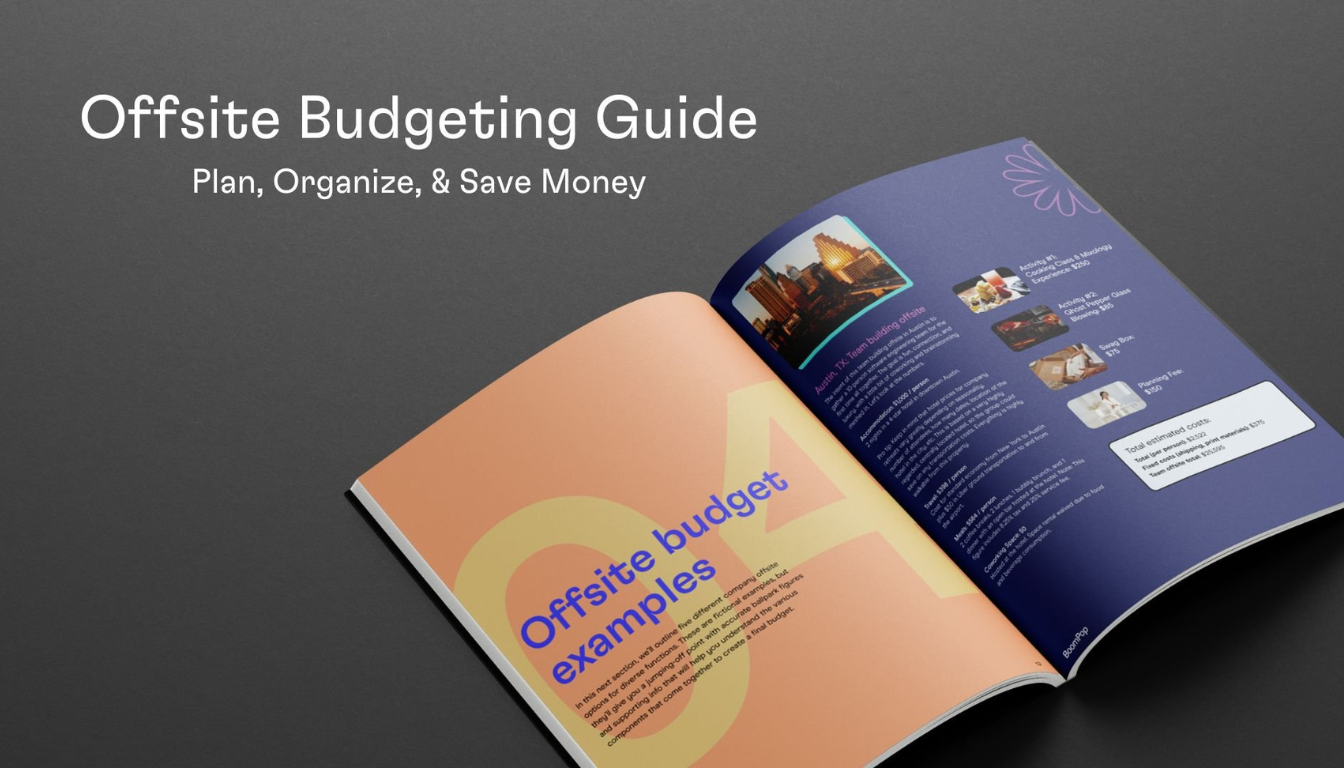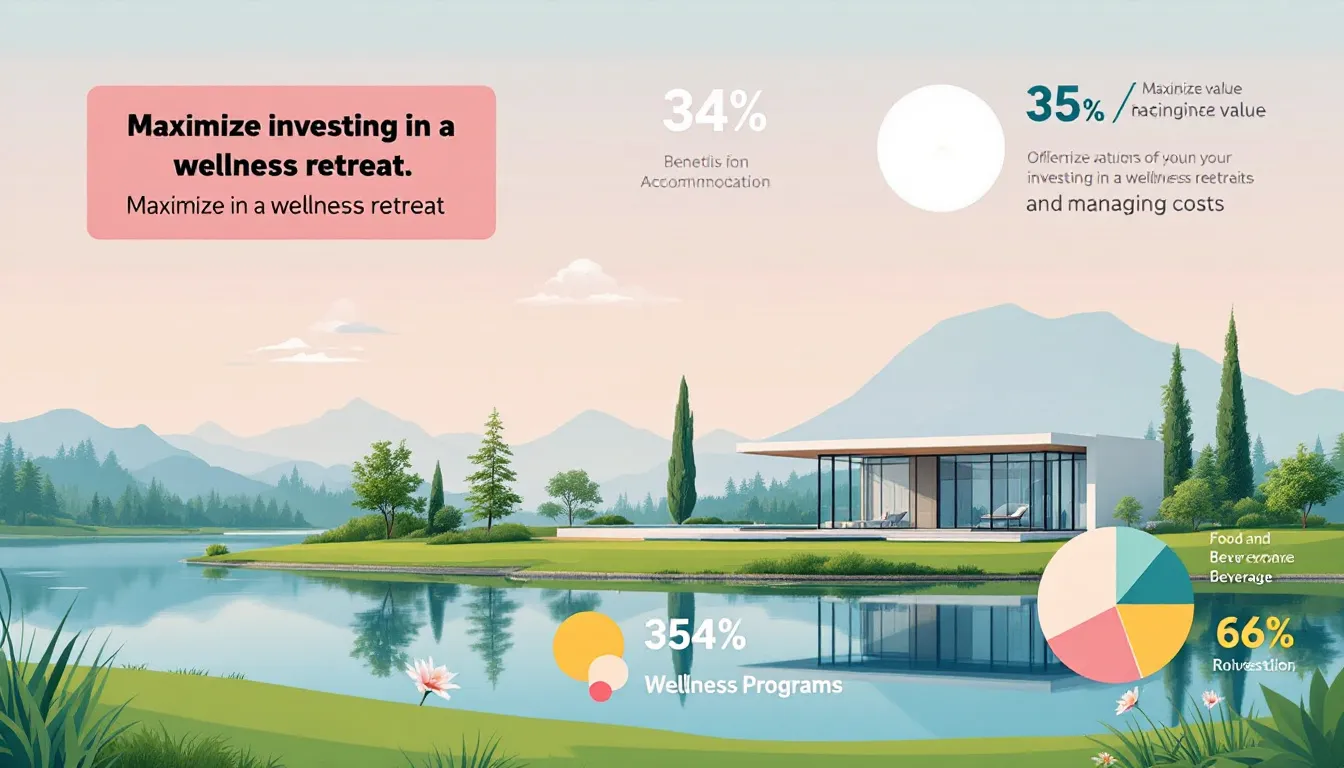The Ultimate Guide to Retreat Costs in 2025: Budgeting and Planning Tips

Curious about retreat costs? The cost of retreats varies widely, with wellness retreats ranging from $500 to over $5,000 and corporate retreats often costing around $4,000 per person. In this guide, we break down these costs and discuss the factors that influence them to help you plan your budget effectively.
Key Takeaways
- Understanding retreat costs is essential for effective planning and requires awareness of average expenses and influencing factors, including type of retreat and location.
- Budgeting for retreats should encompass all expected expenses and utilize strategies like the Quarter Rule to allocate funds effectively while accounting for potential hidden costs.
- Choosing the right venue significantly impacts both costs and attendee experience; local venues generally lower transportation costs while unique international options offer distinct experiences.
Understanding Retreat Costs

Grasping retreat costs is crucial for effective planning. Knowing average expenses and the influencing factors aids in better budget management and enhances planning success. Whether planning a wellness retreat or a corporate event, understanding expenditures helps make informed decisions that align with your retreat’s goals.
The cost of retreats varies significantly depending on several factors. For example, wellness retreats typically cost less per person compared to corporate retreats. These differences highlight the need for retreat leaders to have a comprehensive understanding of the various elements that can impact the overall retreat cost.
Average Retreat Cost Breakdown
The average cost of a corporate retreat per person in 2023 was around $4,000. This figure includes expenses such as accommodation, meals, activities, and other essential services. For smaller companies, the cost typically ranges from $500 to $1,000 per person. These costs have been rising, with the typical company retreat budget reaching about $700 per person per night after 2020.
On the other hand, wellness retreats can range significantly in price, from $500 to over $5,000 depending on the level of luxury and services offered. Locations like Aro Ha in New Zealand offer a 6-day wellness retreat starting at $4,263, while programs like the Sustainable Weight Loss Program at Canyon Ranch can cost $1,125 per person per night.
All-inclusive wellness retreats often reduce the number of separate expenses, covering meals, accommodations, well-being, and activities.
Factors Influencing Retreat Costs
Multiple factors significantly impact the overall cost of a retreat. Location is key; destinations in Eastern Europe, Southeast Asia, and Central America are often more affordable than those in North America or Western Europe. The retreat’s duration also affects costs, with longer stays naturally incurring higher expenses.
The type of accommodation and the services provided are other critical factors. All-inclusive wellness retreats may have higher upfront costs but can save money in the long run by covering all necessary expenses. Additionally, the specific amenities and activities included in the retreat package, such as healthy meals, specialized programs, and treatments, can vary the price significantly.
Budgeting for a Company Retreat

Crafting a comprehensive budget is vital for planning a successful company retreat. Aligning the budget with specific goals ensures all necessary activities and services are covered. A well-structured budget typically includes accommodation, venue rental, transportation, meals, supplies, staff pay, and instructor compensation.
The first step in planning a company retreat is to determine your starting budget. Utilizing tools like budget templates and estimators can streamline this process, helping you manage unexpected costs and adhere to budget limits. A smart budgeting plan not only helps in creating a memorable retreat but also ensures profitability.
Setting a Realistic Budget
A realistic budget starts with a clear understanding of all expected expenses. Identifying the retreat’s specific goals is crucial, as they dictate the necessary activities and services, influencing budget requirements. Retreat leaders must include costs related to expertise, planning, teaching, hosting, and facilitating to ensure comprehensive coverage.
Models like Good, Better, and Best help set profit goals and determine pricing structures for business. Opting for budget-friendly venues such as community centers or local parks can offer significant savings while still making sense of the retreat’s basic needs. If that sounds good, it’s worth considering.
Consulting a retreat specialist offers personalized support in budgeting and planning, ensuring all aspects are considered.
Allocating Funds Wisely
The Quarter Rule is an effective budget strategy that divides the budget into four main categories: accommodation, travel, meals, and activities. This approach provides clarity on affordable destinations, suitable hotels, retreat length, and activities.
Locations in Eastern Europe, Southeast Asia, or Central America often provide more affordable retreat options. When budgeting for a corporate retreat, comparing hotel, restaurant, and excursion costs in various destinations helps find the most cost-effective options. Choosing an easily accessible venue enhances participation and overall employee satisfaction.
Hidden Costs to Consider
Overlooked hidden costs can significantly impact the total retreat budget. Common overlooked expenses include resort fees, gratuities, alcohol, company swag, shipping costs, and extra baggage. These additional costs can add up quickly, affecting the overall financial planning of the retreat.
Meals typically account for approximately 25% of the total budget for a retreat. Using budget estimators can aid in forecasting these hidden costs by breaking down expenses into categories like accommodation, transportation, and meals.
Considering all potential expenses in the budget prevents unexpected financial strain and ensures that participants can expect a smooth retreat experience outside their comfort zone, while also keeping track of total costs and revenue.
Choosing the Right Retreat Venue

Choosing the right venue is crucial and can significantly impact the overall experience and costs. Local venues often reduce transportation costs and logistical challenges compared to international locations, which typically involve higher travel and accommodation expenses despite offering unique experiences.
Consider the various venue types, from luxury resorts to budget-friendly options like community centers or schools. Each venue type has its own costs and amenities, influencing the overall budget for events.
Domestic vs. International Locations
Deciding between domestic and international destinations involves weighing unique cultural experiences against cost implications in the world. Domestic retreats generally incur lower costs and logistical burdens, making them more budget-friendly compared to international experiences.
International retreats provide unique experiences but require a larger budget due to higher travel and accommodation costs. Transportation alone typically accounts for 15-25% of the total corporate retreat budget. Choosing a local retreat destination often results in lower travel expenses and easier logistics.
Venue Types and Their Costs
Luxury resorts offer extensive amenities but come with higher price tags, often consuming a larger portion of the budget. These venues’ premium amenities and services can significantly raise the total retreat cost.
Unique venues like wellness centers may offer specialized services justifying their pricing, appealing to specific themes. For a strategic retreat, venue costs typically represent about 35% of the overall budget.
Budget-friendly options like community centers or local parks help keep costs manageable and afford a good price way to enjoy recreational activities.
Sample Retreat Budgets

A structured budget, an art of budgeting in itself, aids in effective planning and ensures all essential costs are covered, as planned, providing an advantage.
Here are sample budgets for different types of retreats to illustrate fund allocation.
Small Team Offsite in Austin, TX
For a 10-person team building retreat in Austin, TX, the total estimated cost is $25,595. The accommodation cost is $1,000 per person, with additional budget allocated for meals ($564) and activities such as a cooking class and mixology experience ($250).
Additional costs include coworking space rental at $45 per day per person and a swag box for participants at $75 each. This detailed budget breakdown aids in understanding effective fund allocation for a small team offsite.
Large Corporate Retreat in San Francisco, CA
For a 75-person team offsite in San Francisco, CA, the total estimated cost is $232,875. The estimated cost per person is $3,045, with accommodation costs amounting to $1,380 per person.
The budget also includes a planning fee of $150 and travel costs for participants from Dallas to San Francisco totaling $450 each. This comprehensive budget example showcases the financial planning needed for a large corporate retreat.
Executive Retreat in New York, NY
The estimated cost per person for a luxury executive retreat in New York City is approximately $3,571. Accommodation costs for such retreats average around $1,400 per person.
This budget example highlights the higher costs of luxury executive retreats, emphasizing the need to spend carefully on planning and fund allocation for a successful and memorable event.
Tools and Resources for Planning
The right tools and resources greatly enhance the efficiency of retreat planning and budgeting. Resources like event budget templates and the Ultimate Budgeting Guide ebook are highly recommended for building a comprehensive budget.
Platforms like SquadTrip support retreat leaders by tracking earnings, expenses, and profit margins for each trip. A retreat booking system simplifies managing reservations and payments, ensuring a seamless planning experience.
Using Budget Estimators
Budget estimators play a crucial role in planning retreats by providing a clearer picture of potential expenses. Online budget estimators streamline the budgeting process, ensuring accurate cost predictions and efficient financial planning.
These tools categorize expenses like accommodation, transportation, and meals, making it easier to manage and forecast costs. Incorporating budget estimators into your planning prevents unexpected financial surprises and ensures a balanced budget.
Consulting Experts
Planning professionals significantly enhance the retreat experience with expert insights and tailored strategies. Engaging a retreat consultant ensures effective incorporation of participant engagement and organizational goals into the planning process.
Experts offer valuable tips and support, helping navigate retreat planning complexities and ensuring all aspects are considered. Consulting with professionals can lead to a more organized, efficient, and successful retreat.
Maximizing Value from Your Retreat

Maximizing retreat value involves selecting the right venue and incorporating activities that boost team engagement and morale. The venue significantly influences attendee engagement and overall experience, making it crucial in retreat planning.
Corporate retreats boost employee morale and productivity, fostering meaningful professional connections and enhancing collaboration. Focusing on the right elements ensures a high return on investment from your retreat.
Focusing on Team Building
An effective day retreat program combines learning with community activities and downtime for optimal engagement. Unique venues like wellness centers provide specialized experiences that enhance the retreat’s value without necessarily being expensive. This course offers a holistic approach to personal growth.
Team building exercises foster collaboration and strengthen participant relationships within a group. These activities boost employees’ creativity and morale, leading to a more cohesive and productive team. The fun part of these exercises is that they can be tailored to fit the specific dynamics of the fun group.
Evaluating ROI
Aligning retreat activities with company objectives boosts the overall return on investment or ROI. Team building activities during retreats boost employees’ creativity and morale, leading to better collaboration and improved workplace relationships.
Analyzing post-retreat feedback provides insights into the event’s effectiveness and impact. Assessing direct and indirect costs helps evaluate the retreat’s full impact on the company, ensuring the investment yields meaningful benefits.
Summary
Summarizing the key points of the article, this section highlights the importance of understanding retreat costs, setting a realistic budget, choosing the right venue, and maximizing the value of the retreat. It emphasizes the need for careful planning and effective budgeting to ensure a successful and memorable retreat experience. Companies like Offsite specialize in organizing seamless retreat experiences by handling logistics, team building activities, venue selection, and on-site coordination, allowing teams to focus on connection and growth.
The conclusion inspires the reader to take the insights gained from this guide and apply them to their retreat planning process, ensuring a well-organized and impactful event that aligns with their company’s goals.
FAQs
- What factors impact the cost of a company retreat?
The cost of a company retreat is significantly impacted by factors such as location, duration, accommodation options, and included activities. Additionally, transportation and hidden costs like gratuities can substantially affect the overall expenses.
- How can I set a realistic budget for my company retreat?
To set a realistic budget for your company retreat, identify all expected expenses such as accommodation, travel, meals, and activities. Utilizing pricing models like Good, Better, and Best can assist in establishing profit goals and developing an effective pricing structure.
- What are some common hidden costs to consider when planning a retreat?
When planning a retreat, be mindful of hidden costs such as resort fees, gratuities, alcohol, and meals, as these can significantly impact your budget. Including expenses for company swag and shipping can also lead to unexpected financial strains.
- What types of venues are available for retreats, and how do their costs compare?
Retreat venues include luxury resorts, which offer extensive amenities at a higher cost, and budget-friendly options like community centers that provide significant savings. Choosing the right venue depends on your budget and the amenities you desire.
You may also like
Unique spaces for your next offsite
Find distinctive venues for your upcoming corporate retreat.
Stay Updated with Our Insights
Get exclusive content and valuable updates directly to you.







